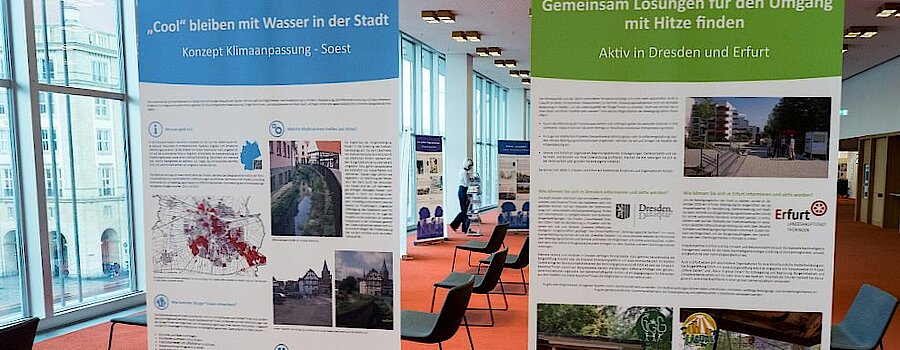Exhibitions are an opportunity to inform the general public about research findings and thereby raise general awareness of challenges but also of approaches to solutions in the field of spatial sustainability transformations. The IOER regularly participates in exhibitions by providing information and exhibits. Furthermore, the Institute also designs its own exhibitions on selected topics.
Most of our exhibitions are designed as travelling exhibitions. Interested parties can show them on their own premises.
Please do not hesitate to contact us if you are interested.
![[Translate to English:] Eine Frau steht mit dem Rücken zur Kamera vor drei Ausstellungstafeln.](/fileadmin/user_upload/Presse/_processed_/b/a/csm_Foto_Ausstellung_Gestalt-des-Raumes_ASchielicke-IOER-Media_RS12867-1_5c3012331c.jpg)
The exhibition by IOER and Federal Institute for Research on Building, Urban Affairs and Spatial Development (BBSR) (based on the book of the same name) uses a large number of aerial photographs to provide an impressive and sometimes surprising view of the various facets of land use in Germany.
Exhibition catalogue (in German, PDF app. 35 MB)

The exhibition is the result of the planning laboratory of the same name. The spatial imaginaries - visions, thought experiments and food for thought - make the diverse possibilities of the region visible, show how much potential there is in Lusatia and what role regional planning strategies can play in shaping regional structural change.
In addition to the exhibition, a broschure (in German) documents the process of creating the spatial imaginaries.

The exhibition was conceived in the German-Polish cooperation project of the same name. It provides information about the history and architectural heritage of the ten towns involved in the project and how both can be used to revitalise the historic centres.
The mostly eventful history of the participating cities from south-western Poland and eastern Saxony is presented by a selection of visual material and texts
Further information on the exhibition (in German)
More and more people around the world live in cities. Natural soil must give way to houses, squares and streets. In Germany, too, more and more soil is being sealed. Among other things, the exhibition traces the settlement development of the Dresden Elbe Valley, explains the different demands on the limited resource of land and shows possible solutions for reducing the constant consumption of land.
The exhibition was created in the joint project HeatResilientCity. It shows examples of adaptation to summer heat in various municipalities in Germany.
The IOER developed the interactive exhibit "The Green City" for the 2015 Year of Science with its focus on the topic "The City of the Future". The exhibit illustrates the diversity of ecological urban development as well as the steps that everyone can take to achieve balance in their local environment. In 2015 the IOER contributed this exhibit to an exhibition on board the floating science centre MS Wissenschaft. In the meantime, "The Green City" has found a permanent home in the Institute in Dresden.



![[Translate to English:] Leibniz Gemeinschaft](/fileadmin/user_upload/ioer_de/img/logo-leibniz-gemeinschaft.svg)
![[Translate to English:] Dresden concept](/fileadmin/_processed_/2/1/csm_logo-dresden-concept_430c661ad7.png)

